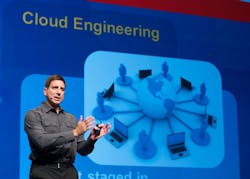In his keynote at the Honeywell Users Group (HUG) Americas Symposium this week in San Antonio, Texas, Vimal Kapur, the new president of Honeywell Process Solutions, outlined the merits of Universal IO, calling it “transformational.” But he also said that the capabilities the software-programmable I/O offers really has no value without combining it with a lean execution model. That means bringing projects to the people using cloud computing, and enabling parallel engineering through virtualization.
It’s those three elements—Universal IO, virtualization and cloud engineering—that make up Lean Execution of Automation Projects (LEAP), a service offering that HPS launched this week to help process manufacturers get plants up and running in significantly reduced timeframes and budgets.
HPS executives have spoken repeatedly at HUG this week about taking automation out of the critical path of project execution. At his popular keynote presentation, Jason Urso, HPS’s chief technology officer, described the instrumentation freeze required in traditional project execution in order to build out the automation and controls near the end of the sequential workflow. A key issue there is that several late changes inevitably come after that freeze, causing considerable rework and delays. Factory acceptance testing (FAT) “occurs late in the project when you can least afford to have a problem,” Urso said.
Honeywell estimates that LEAP can provide an 80 percent reduction in costs related to unnecessary rework. It can also help reduce avoidable schedule delays by as much as 90 percent. It does this by enabling the physical and functional aspects of project execution to be done in parallel, eliminating workflow dependencies.
“The traditional model is very back-end loaded. There is a tremendous number of late changes,” Urso described. “With LEAP, we get started on Day 1. … We’re ramping down when traditional projects are ramping up.”
Honeywell’s Universal IO allows for standardized I/O cabinets that can be configured on site, later in the process. “This gives us the flexibility to ship I/O cabinets much earlier,” said Jack Gregg, director of Experion product marketing at HPS. “Then we can load functional design into the system when we’re ready to commission.” Universal IO provides the flexibility to do change management, he added.
Virtualization provides schedule management. Using virtual machines in the control system removes dependencies between the functional and physical design. Urso pointed to an 80 percent reduction in maintenance, space and energy with virtual servers. Upgrading to a blade server provides a further 80 percent reduction, he said, reducing five servers to one.
Cloud engineering provides resource management. With a secure, centrally hosted cloud environment, project execution and testing can be done anywhere in the world. It brings the project to the experts rather than having to round up all the experts into one location. “We bring the work to the engineers. They don’t need to travel to the staging area,” Urso said. “That way we can apply the best resources wherever they are.”
Gregg outlined the benefits in one case study involving just Universal IO and virtualization:
- Reduced MAC cabinets by 50 percent.
- Reduced marshaling cabinets by 90 percent (at $10,000 per cabinet).
- Reduced cabinet engineering, drawings and documentation, saving up to $1 million.
- Reduced opportunities for marshaling mistakes by 66 percent.
- Reduced capital cost by $16 million (in a normalized $50 million MAC scope).
Managers within Honeywell were asked to evaluate how their own MAC projects would differ if they’d done them with LEAP instead of traditionally. What they reported, Gregg said, was that marshaling cabinets would be reduced from 130 to five, about 30 documents would be completely eliminated, and seven remote instrument enclosures would drop to three.
About the Author
Aaron Hand
Editor-in-Chief, ProFood World

Leaders relevant to this article:
